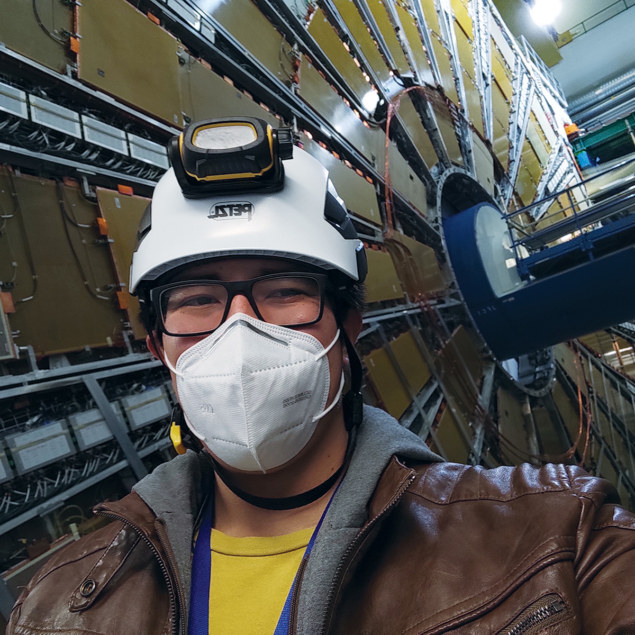If a technical student based at CERN for just one year can become a fully-fledged CERN guide, says Bryan Pérez Tapia, then so can you!

Do you remember the first time you heard about CERN? The first time someone told you about that magical place where bright minds from all over the world work together towards a common goal? Perhaps you saw a picture in a book, or had the chance to visit in person as a student? It is experiences like these that motivate many people to pursue a career in science, whether in particle physics or beyond.
In 2016 I had the pleasure of visiting CERN on a school trip. We toured the Synchrocyclotron and the SM18 magnet test facility. I was hooked. The tour guides talked with passion about the laboratory, the film presenting CERN’s first particle accelerator and the laboratory’s mission, and all those big magnets being tested in SM18. It was this experience that motivated me to study physics at university and to try to come back as soon as I could.
Accreditation
That chance arrived in September 2021 when I started a one-year technical studentship as editorial assistant on the Courier. From the first day I was eager to see as much as I could. During the final months of Long Shutdown 2, my supervisor and I visited the ATLAS cavern. The experience motivated me to ask one of my newly made friends, also a technical student who had recently become a tour guide, how to apply. The process was positive and efficient. After completing all the required courses from the learning hub and shadowing experienced guides, I became a certified ATLAS underground guide in November 2021 and gave my first tour soon after. I was nervous and struggled with the iris scanner when accessing the cavern, but all ended well, and further tours were scheduled. Then, in mid-December, all in-person tours were cancelled due to COVID-19 restrictions. I needn’t have worried, as CERN was fully geared up to provide virtual visits. Among my first virtual audience members were students from the high school that brought me to CERN five years earlier and from my university, Nottingham Trent in the UK.
The most satisfying thing is people’s enthusiasm and their desire to learn more about CERN and its mission
The virtual visits were quite challenging at first. It was harder to connect with the audience than during an in-person visit. But managing these difficulties helped me to improve my communication skills and to develop self-confidence. During this period, I conducted more than 10 virtual visits for different institutes, universities, family and friends, in both English and Spanish.
At the beginning of March 2022, CERN moved into “level yellow” and in-person visits were resumed. Although only possible for a short period, I had the chance to guide visitors underground and had the honour of guiding the last in-person visit into the ATLAS cavern on 23 March before preparations for LHC Run 3 got under way. With the ATLAS cavern then off-limits, I signed up to present at as many CERN visit points as possible. At the time of writing, I am a guide for the Synchrocyclotron, the ATLAS Visitor Centre, Antimatter Factory, Data Centre, Low Energy Ion Ring and CERN Control Centre.
Get involved
The CERN visits service always welcomes new guides and is working towards opening new visit points. Anyone working at CERN or registered as a user can take part by signing up for visit-point training on the tour-guide website: guides.web.cern.ch. General training for new guides is also available. All you need to show CERN to the public is passion and enthusiasm, and you can sign up for as many or as few as your day job allows. Diversity is encouraged and those who are multilingual are also highly valued.
Today, visits are handled by a dedicated section in the Education, Communications and Outreach group. The number of visitors has gradually increased over recent years, with 152,000 annual visitors before the pandemic started, excluding special events such as the CERN Open Days. The profile of visitors ranges from school pupils and university students to common-interest groups such as engineers and scientists, politicians and VIPs, and people with a wide range of interests and educational levels.
The benefits of becoming a CERN guide are immense. It gives you access to areas that would otherwise not be possible, the chance to experience important events in-person and to see your work at CERN, whatever it involves, from a fresh perspective. My personal highlight was watching test collisions at 13.6 TeV before the official start of Run 3 while showing Portuguese high-school students the ATLAS control room. The most satisfying thing is people’s enthusiasm and their desire to learn more about CERN and its mission. I particularly remember how a small child asked me a question about the matter–antimatter asymmetry of the universe, and how another young visitor ran from Entrance B at the end of a tour just to tell me how much she loved the visit.
The visits service makes it as easy as possible to get involved, and exciting times for guides lie ahead with the opening of the CERN Science Gateway next year, which will enable CERN to welcome even more visitors. If a technical student based at CERN for just one year can get involved, so can you!








